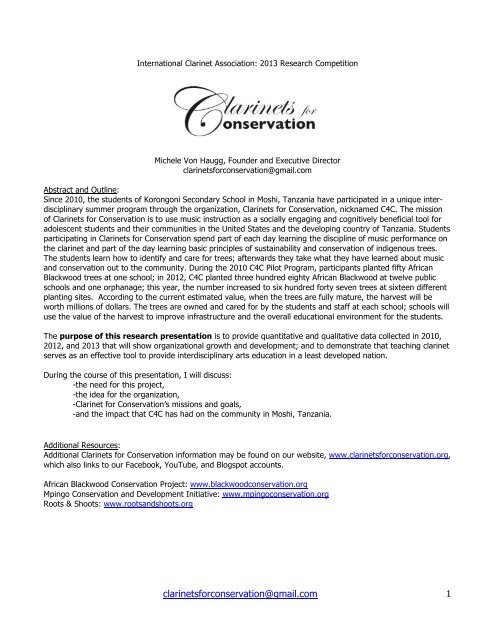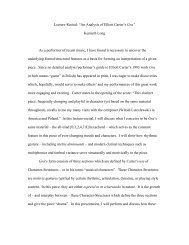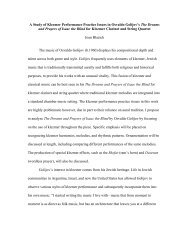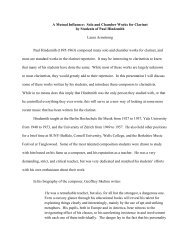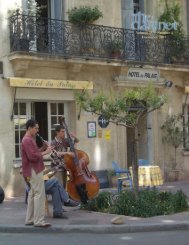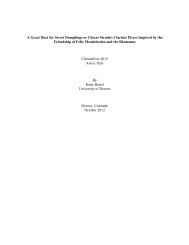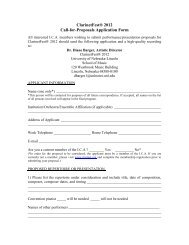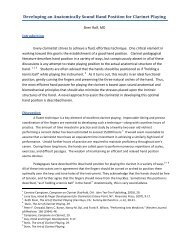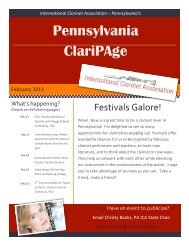Clarinets for Conservation - International Clarinet Association
Clarinets for Conservation - International Clarinet Association
Clarinets for Conservation - International Clarinet Association
You also want an ePaper? Increase the reach of your titles
YUMPU automatically turns print PDFs into web optimized ePapers that Google loves.
<strong>International</strong> <strong>Clarinet</strong> <strong>Association</strong>: 2013 Research CompetitionMichele Von Haugg, Founder and Executive Directorclarinets<strong>for</strong>conservation@gmail.comAbstract and Outline:Since 2010, the students of Korongoni Secondary School in Moshi, Tanzania have participated in a unique interdisciplinarysummer program through the organization, <strong><strong>Clarinet</strong>s</strong> <strong>for</strong> <strong>Conservation</strong>, nicknamed C4C. The missionof <strong><strong>Clarinet</strong>s</strong> <strong>for</strong> <strong>Conservation</strong> is to use music instruction as a socially engaging and cognitively beneficial tool <strong>for</strong>adolescent students and their communities in the United States and the developing country of Tanzania. Studentsparticipating in <strong><strong>Clarinet</strong>s</strong> <strong>for</strong> <strong>Conservation</strong> spend part of each day learning the discipline of music per<strong>for</strong>mance onthe clarinet and part of the day learning basic principles of sustainability and conservation of indigenous trees.The students learn how to identify and care <strong>for</strong> trees; afterwards they take what they have learned about musicand conservation out to the community. During the 2010 C4C Pilot Program, participants planted fifty AfricanBlackwood trees at one school; in 2012, C4C planted three hundred eighty African Blackwood at twelve publicschools and one orphanage; this year, the number increased to six hundred <strong>for</strong>ty seven trees at sixteen differentplanting sites. According to the current estimated value, when the trees are fully mature, the harvest will beworth millions of dollars. The trees are owned and cared <strong>for</strong> by the students and staff at each school; schools willuse the value of the harvest to improve infrastructure and the overall educational environment <strong>for</strong> the students.The purpose of this research presentation is to provide quantitative and qualitative data collected in 2010,2012, and 2013 that will show organizational growth and development; and to demonstrate that teaching clarinetserves as an effective tool to provide interdisciplinary arts education in a least developed nation.During the course of this presentation, I will discuss:-the need <strong>for</strong> this project,-the idea <strong>for</strong> the organization,-<strong>Clarinet</strong> <strong>for</strong> <strong>Conservation</strong>’s missions and goals,-and the impact that C4C has had on the community in Moshi, Tanzania.Additional Resources:Additional <strong><strong>Clarinet</strong>s</strong> <strong>for</strong> <strong>Conservation</strong> in<strong>for</strong>mation may be found on our website, www.clarinets<strong>for</strong>conservation.org,which also links to our Facebook, YouTube, and Blogspot accounts.African Blackwood <strong>Conservation</strong> Project: www.blackwoodconservation.orgMpingo <strong>Conservation</strong> and Development Initiative: www.mpingoconservation.orgRoots & Shoots: www.rootsandshoots.orgclarinets<strong>for</strong>conservation@gmail.com1
Selected Bibliography:Bayer, Landon E. The Arts, Popular Culture, and Social Change. New York, NY: Peter Lang Publishing, 2000.Bittman, B., et al. "Recreational Music-Making Modulates the Human Stress Response: A PreliminaryIndividualized Gene Expression Strategy." Medical Science Monitor (2005) 11(2): 31-40.“Carbon Tanzania.” http://www.carbontanzania.com (accessed November 12, 2012).Ho, P., et al. "The Impact of Group Drumming on Social-Emotional Behavior in Low-Income Children." Evidence-Based Complementary and Alternative Medicine (2011): 1-14.Hollinger, Diane M. "Instrument of Social Re<strong>for</strong>m: A Case Study of the Venezuelan System of Youth Orchestras."D.M.A. dissertation, Arizona State University, 2006.Kagan, Jerome. "Keynote: Why the Arts Matter. Six Good Reasons <strong>for</strong> Advocating the Importance of Arts inSchool." In Neuroeducation: Learning, Arts and the Brain. Findings and Challenges <strong>for</strong> Educators and Researchersfrom the 2009 Johns Hopkins University Summit, edited by Barbara Rich and Johanna Goldberg, 29-36. NewYork/Washington D.C.: Dana Press, 2002.Kraus, N. “Musical Training Gives Edge in Auditory Processing.” The Hearing Journal 64, no 2 (Feb 2011): 10-16.Kraus, N., and B. Chandrasekaran “Music Training <strong>for</strong> the Development of Auditory Skills.” Nature ReviewsNeuroscience 11(2010): 599-605.Lamont, Alexandra. "Musical Identities and the School Environment." In Musical Identities. edited by RaymondA.R. MacDonald, David J. Hargreaves, and Dorothy Miell, 41-59. Ox<strong>for</strong>d: Ox<strong>for</strong>d University Press, 2002.Lakshmanan, Indira. 2005. "For Venezuela's Poor, Music Opens Doors: Classical Program Trans<strong>for</strong>ms Lives."Boston Globe. 22 June 2005.Parbery-Clark, A., E. Skoe, C. Lam, and N. Kraus. “Musician Enhancement <strong>for</strong> Speech-In- Noise.” Ear and Hearing30 (2009):653-661.“Science Daily: Your Source <strong>for</strong> the Latest Research News.” Music Education Can Help Children Improve ReadingSkills. http://www.sciencedaily.com/ (accessed November 1, 2012).Small, Christopher. Music, Society, Education. Hanover, NH: Wesleyan University Press, 1996.Straight, D.L., J. Hornickel, and N. Kraus “Subcortical Processing of Speech Regularities Underlies Reading andMusic Aptitude in Children.” Behavioral and Brain Functions (2011): 7:44, doi: 10.1186/1744-9081-7-44.Strait, D.L., and N. Kraus “Playing Music <strong>for</strong> a Smarter Ear: Cognitive, Perceptual and Neurobiological Evidence.”Music Perception vol. 29 issue 2 (2011):133-146.United Nations Children’s Fund. Progress <strong>for</strong> Children: A Report Card <strong>for</strong> Adolescents. New York: United NationsPublications, 2012.United Nations Educational, Scientific and Cultural Organization. “World Data on Education: United Republic ofTanzania.” (2010/11): 7 th Edition.Walker, Robert. Music Education: Cultural Values, Social Change and Innovation. Springfield, IL: Charles C.Thomas Publisher, 2007.clarinets<strong>for</strong>conservation@gmail.com2
Satisfation and Desire <strong>for</strong> Continued Per<strong>for</strong>mance and Learning Do you enjoy the clarinet? Do you practice at home? Would you like a music program at Korongoni Secondary School? Yes No Sometimes or Maybe Would you like an opportunity to join the Police Academy Band? 0 5 10 15 20 Interdisciplinary Knowledge and Learning Sometimes or Maybe No Yes When you Girst saw the clarinet did you know it came from mpingo? 0 16 2 Do you think that we should plant trees? 0 19 Do you think that clarinet music can help people protect and plant trees? 0 19 Do you think that the clarinet helps people to remember mpingo? 0 19 clarinets<strong>for</strong>conservation@gmail.com3
Organizational Growth Teachers Musical Engagements Planting Sites Students 17 16 14 12 12 9 5 1 1 1 2 3 2010 2012 2013 Special thanks to the 2013Guest Artist TeachersMark FuginaAudrey MillerKatie PalmerJothi RagavanGary SperlField ProducerBradley Rodriguez<strong>Conservation</strong>istsSebastian ChuwaSamweli MochuwaOscar MochuwaKorongoni Secondary School Assistant TeacherClara Jordanclarinets<strong>for</strong>conservation@gmail.com4


